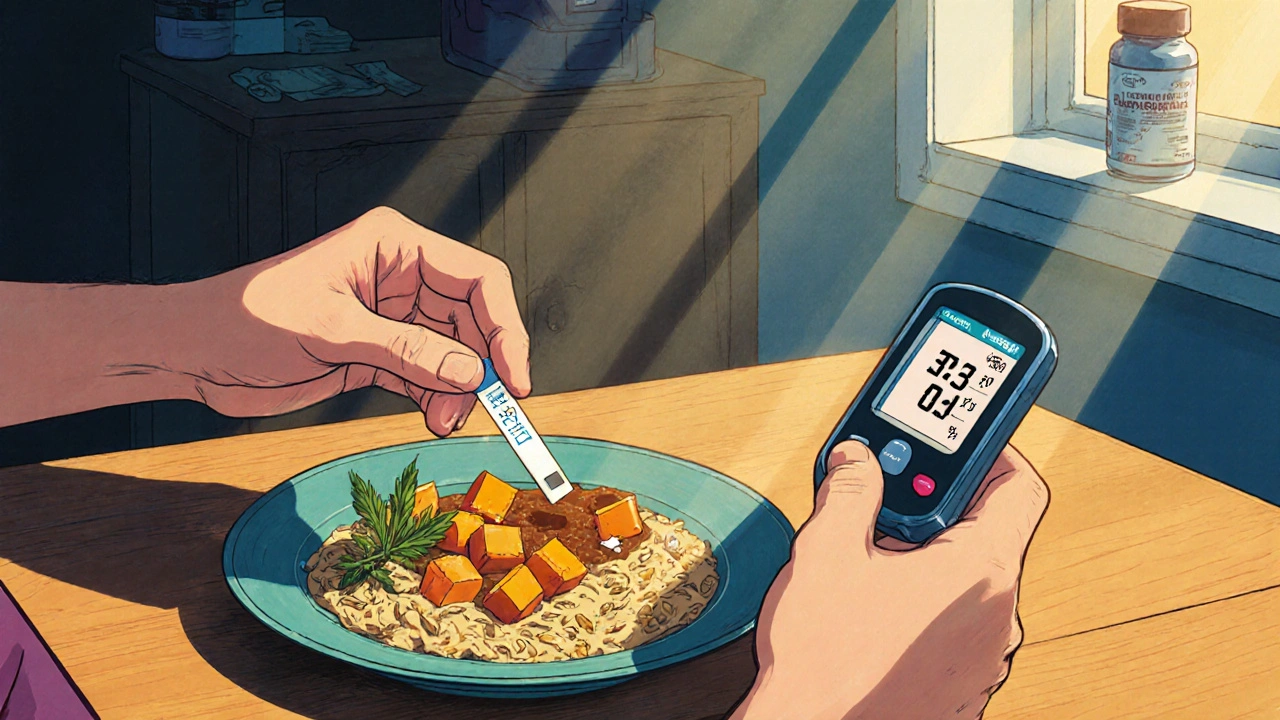Clenbuterol Blood Sugar Estimator
This tool estimates the potential impact of clenbuterol on blood glucose levels based on dosage, health factors, and timing. Results are for educational purposes only and should not replace medical advice.
Estimated Blood Sugar Impact
Click the calculate button to see your results
Quick Takeaways
- Clenbuterol boosts metabolism by stimulating beta‑2 receptors, which can raise blood glucose.
- People with insulin resistance or type 2 diabetes are most vulnerable to spikes.
- Frequent glucose monitoring, balanced meals, and modest dosing can blunt unwanted rises.
- Alternative stimulants like ephedrine have similar sugar effects but differ in potency and side‑effects.
- Stop using clenbuterol if you notice persistent hyperglycemia or severe jitteriness.
When discussing performance‑enhancing compounds, Clenbuterol is a synthetic beta‑2 adrenergic agonist originally developed for asthma relief that many use off‑label for fat loss. Its reputation for torching stubborn fat makes it popular in bodybuilding circles, but the same pathways that melt adipose tissue also tug at your blood‑sugar balance. Below you’ll find a step‑by‑step guide to understand the link, watch your glucose, and stay safe.
How Clenbuterol Works: The Metabolic Shortcut
Clenbuterol binds to the Beta‑2 adrenergic receptor, a protein on cell membranes that normally reacts to adrenaline. Activation triggers a cascade of intracellular signals-chiefly the cyclic AMP (cAMP) pathway-which ramps up two key processes:
- Lipolysis: breakdown of stored fat into free fatty acids, giving muscles a quick energy source.
- Thermogenesis: heat production that raises basal metabolic rate by up to 30 % in some users.
While the fat‑burning effect is desirable for athletes, the same cAMP surge also pushes the liver to release glucose through Glycogenolysis. In short, your body thinks it’s in a fight‑or‑flight state and floods the bloodstream with sugar to fuel the sudden energy demand.
Impact on Glucose Metabolism: Why Blood Sugar Can Spike
The liver’s glucose dump isn’t the only culprit. Beta‑2 stimulation also reduces the effectiveness of Insulin, the hormone that normally moves glucose from blood into cells. Researchers measuring clenbuterol‑treated rats observed a 15‑20 % drop in insulin‑mediated glucose uptake, meaning the same amount of sugar stays longer in circulation.
For a healthy person with a robust pancreas, the pancreas may crank out more insulin to compensate, keeping levels in a normal range. However, anyone with pre‑existing insulin resistance-especially those diagnosed with Type 2 diabetes-might see a pronounced hyperglycemic episode after just a single dose.

Who Should Be Extra Cautious?
Even though clenbuterol is not a prescription drug in many countries, it still carries a medical label. The following groups face higher risk:
- Individuals diagnosed with type 2 diabetes or pre‑diabetes.
- People on insulin therapy or sulfonylureas, where an unexpected sugar surge can cause dangerous swings.
- Athletes with a family history of metabolic disorders.
- Those already taking other stimulants (e.g., caffeine, ephedrine) that amplify catecholamine release.
If any of these apply, consider consulting a healthcare professional before starting clenbuterol cycles.
Monitoring Blood Sugar While Using Clenbuterol
Real‑time data is your best defense. Here’s a practical monitoring routine:
- Baseline test: Take a fasting glucose reading the morning before your first dose.
- Post‑dose check: Measure glucose 30‑45 minutes after dosing; this captures the peak cAMP effect.
- Evening review: A final reading before bedtime helps spot delayed spikes.
For those using continuous glucose monitors (CGM), look for trends rather than isolated spikes. A consistent upward drift over several days signals that dosing or nutrition needs adjustment.
Practical Strategies to Keep Glucose Stable
Below are proven tactics that sport‑science and endocrinology circles swear by:
- Pair doses with carbohydrate‑protein meals: A 30 g carb + 15 g protein plate (e.g., oatmeal with whey) provides glucose that can be shuttled into muscle cells, reducing the surplus in blood.
- Use the lowest effective dose: Studies suggest 20-40 µg per day is enough for modest fat loss; higher doses dramatically increase hyperglycemia risk.
- Cycle wisely: A 2‑week on/2‑week off pattern gives the pancreas a break, preventing chronic insulin desensitization.
- Stay hydrated: Water supports kidney filtration of excess glucose and reduces the chance of dehydration‑induced cortisol spikes.
- Incorporate light cardio after dosing: A 20‑minute walk can help muscles absorb the extra glucose released by the liver.

Comparing Clenbuterol to Other Stimulants
Many users wonder whether a different compound might spare their sugar levels. The table below summarizes the key metabolic differences between clenbuterol, ephedrine, and thyroid hormone (T3), the three most common off‑label choices for fat loss.
| Compound | Primary receptor | Effect on glucose | Typical dose (human) | Side‑effect profile |
|---|---|---|---|---|
| Clenbuterol | Beta‑2 adrenergic | ↑ hepatic glucose output, ↓ insulin sensitivity | 20‑40 µg/day | Tachycardia, tremor, electrolyte loss |
| Ephedrine | Mixed alpha/beta adrenergic | Modest ↑ glucose, less insulin resistance | 20‑50 mg 3×/day | Hypertension, insomnia, anxiety |
| T3 (Liothyronine) | Thyroid hormone receptor | ↑ basal metabolism, slight ↑ glucose | 25‑50 µg/day | Cardiac arrhythmia, bone loss |
While all three raise metabolic rate, clenbuterol is the most aggressive at forcing the liver to dump sugar. If glucose control is a priority, many users opt for low‑dose ephedrine combined with a strict carb‑timing plan.
Common Pitfalls and Red Flags
Even seasoned athletes can slip into habits that sky‑rocket blood sugar:
- Skipping meals: A popular “fasted” approach removes the carbohydrate buffer, leaving the liver’s glucose release unchecked.
- Stacking with high‑dose caffeine: Synergistic catecholamine spikes can push glucose 30‑40 mg/dL higher than clenbuterol alone.
- Ignoring early signs: Light‑headedness, frequent urination, or sudden thirst often precede a hyperglycemic episode.
At the first sign of persistent fasting glucose above 126 mg/dL, stop the cycle and seek medical advice.
Frequently Asked Questions
Does clenbuterol cause diabetes?
Short‑term use does not diagnose diabetes, but repeated insulin resistance can accelerate the onset in susceptible individuals. Monitoring and moderation are essential.
How often should I check my glucose while on a clenbuterol cycle?
At minimum, take a fasting reading before the first dose, then a post‑dose reading 30‑45 minutes after each dose. If you have a CGM, watch for any sustained upward trend.
Can I offset glucose spikes with carbs?
Yes. Consuming a moderate amount of low‑glycemic carbs (e.g., sweet potato, quinoa) with protein helps shuttle glucose into muscle cells instead of staying in the bloodstream.
Is ephedrine a safer alternative for blood sugar?
Ephedrine typically causes a milder rise in glucose and less insulin resistance, making it a better option for those with borderline glucose control. However, it carries its own cardiovascular risks.
What’s the best way to stop a clenbuterol cycle if my glucose spikes?
Gradually taper the dose over 3‑5 days rather than stopping cold, while increasing water intake and focusing on balanced meals. If fasting glucose stays above 126 mg/dL, see a doctor immediately.
Managing blood sugar while using Clenbuterol isn’t rocket science, but it does require attention to dosing, nutrition, and regular glucose checks. By understanding the underlying mechanisms and following the practical steps above, you can enjoy the metabolic boost without letting your sugar go haywire.

Naomi Shimberg
October 23, 2025 AT 13:15While the prevailing consensus extols the metabolic virtues of clenbuterol, one must also consider the deleterious glucose perturbations it engenders. The beta‑2 adrenergic stimulation, though efficacious for lipolysis, concurrently activates hepatic glycogenolysis, thereby elevating plasma glucose concentrations. Moreover, insulin signaling attenuation underlies a transient insulin resistance that may prove precarious for individuals with compromised glycemic homeostasis. Consequently, a judicious dosing regimen, coupled with rigorous glucose monitoring, is indispensable. In my estimation, the risk–benefit calculus tilts unfavorably for those predisposed to type‑2 diabetes, and alternative agents should be contemplated. Finally, discontinuation at the first sign of sustained hyperglycaemia is advisable.
Zachary Blackwell
November 4, 2025 AT 02:02Yo fam, they don’t want you to know that the pharma giants purposely hide the sugar spike side‑effects of clen. If you’re stacking it with caffeine or ephedrine you’re basically signing up for a covert glucose bomb. Keep your CGM on 24/7, trust no “quick fix” hype, and remember that the only real control is your own data. Stay woke and stay safe.
CASEY PERRY
November 15, 2025 AT 15:49The pharmacodynamics of β2‑agonism precipitate hepatic glycogenolysis, thereby augmenting plasma glucose; concomitant insulin receptor desensitization further impairs glucose uptake, necessitating vigilant monitoring.
kenny lastimosa
November 27, 2025 AT 05:35One could argue that the pursuit of a leaner physique ought to be tempered by an awareness of metabolic trade‑offs. The acute thermogenic surge delivered by clenbuterol is alluring, yet its chronic influence on insulin sensitivity invites speculation. Perhaps the most prudent path lies in modest dosing cycles, allowing endogenous regulatory mechanisms to recover. In this way, the athlete honors both performance and physiological integrity.
Heather ehlschide
December 8, 2025 AT 19:22Always keep a glucose log before and after each dose.
Kajal Gupta
December 20, 2025 AT 09:09Alright buddy, let’s break it down in plain English-clenbuterol is like that hyperactive friend who revs up every party, but also steals the dessert table when you’re not looking. Pair it with a solid carb‑protein combo, and you give the sugar a “home base” instead of letting it wander the bloodstream. Think of your meals as traffic lights for glucose; green for muscles, red for excess. Stay hydrated, move a bit after dosing, and you’ll keep the metabolic fireworks from turning into a sugar flare‑up. In short, balance is the secret sauce.